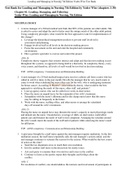Thesis
Example - Final Management Thesis (Qualitative Research) + Interviews + Codebook
- Course
- Institution
- Book
This MP is a qualitative research that was graded with an 8.5. This document will be especially useful for you if you need help understanding the process of qualitative coding methods, and would like to see how a year 4 management project should be structured,.
[Show more]














